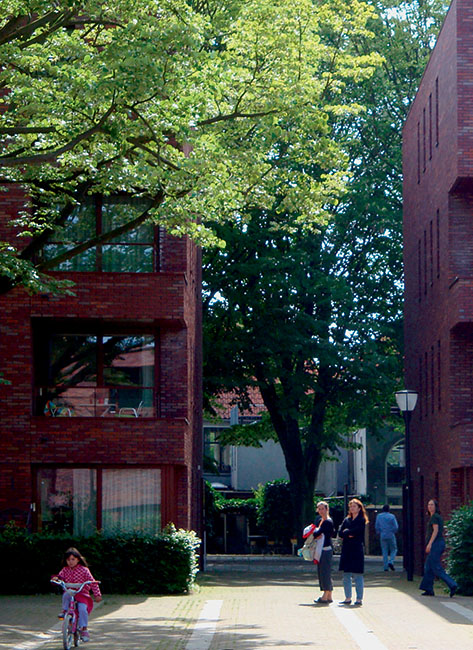De particulier-publieke paradox van de nieuwe open ruimte
DOI:
https://doi.org/10.7480/dash.01.4524Samenvatting
De paradox van de nieuwe open ruimte binnen het woonensemble is haar dubbelzinnige karakter: ze wil zowel publiek als particulier zijn.2 Een toevallig bezoek aan Mariaplaats, een moderne doolhof van stegen en pleintjes, begrensd door strenge roodbruine muren en plaveisels in de oude binnenstad van Utrecht, biedt misschien een aangenaam gevoel van herkenning, maar tegelijkertijd van vervreemding. De herinnering aan oud- Hollandse hofjes dient zich aan, maar het gaat hier niet om armenhuisjes en er heerst zeker geen sfeer van keuvelende en was-ophangende buurvrouwen. Integendeel, de sfeer is eerder anoniem en afstandelijk. Van wie, of voor wie, zijn deze pleintjes bestemd? Wie maakt er gebruik van en wat voor gebruik wordt ervan gemaakt?
Zo zal de wandelaar over het ‘landgoed’ Zwanenwoud in Heerenveen genieten van de Franse, formele tuinaanleg van de parterre en van de kasteelachtige silhouetten die de groene ruimte omzomen, maar tegelijkertijd wordt hij ook in verwarring gebracht: is dit een openbaar park of een tuin voor de bewoners van de aanliggende villa’s, of zijn omgekeerd de bewoners op hun terrassen bedoeld om bekeken te worden door de passanten?
Een bezoeker die het verhoogde dek van De Grote Hof in Ypenburg betreedt, zal allicht met bewondering rondkijken in de indrukwekkende ruimte - alsof men een binnenplaats als die van het Louvre betreedt - en tegelijk voelt hij misschien enige schroom tegenover de intimiteit van een zondagochtendontbijt van bewoners onder de colonnade.
Het is deze paradoxale ervaring die deze ruimten zo fascinerend maakt. Architectonische oplossingen voor deze dubbelzinnigheden blijken bovendien bijzonder vernuftig en steeds anders te zijn. Mariaplaats is een klein, binnenstedelijk project met veel verschillende binnenruimten en met veel woningtypen in een hoge dichtheid, Zwanenwoud betreft een groot grondoppervlak en weinig, identieke woningen, en De Grote Hof is een geïsoleerde enclave van zowel goedkope als dure woningen.
Zoals in het introducerende essay is uiteengezet, is deze nieuwe, dubbelzinnige open ruimte in de stad de uitkomst van een aantal lange, historische ontwikkelingen en actuele vraagstellingen, waaronder de Hollandse traditie van het wonen aan de straat en de vraag naar stedelijkheid en nieuw, publiek domein. Deze twee hoofdkwesties zijn in feite twee kanten van één medaille en ze krijgen in deze ensembles een nieuw moment. Ze zijn nieuwe interpretaties van het wonen (het particuliere) en van het openbare leven (het publieke), waarbij de oude betekenissen van deze categorieën verschuiven en hun eenduidigheid verliezen.
De nieuwe open ruimte brengt de ervaring van de stad binnen het traditionele bouwblok door visuele verbindingen en het toelaten van andere gebruikers, zoals toevallige passanten. Naast de onbepaaldheid van de doorgaande straat vormt de nieuwe open ruimte veelal een ‘plek’, of verblijfsruimte, die autovrij is en een bepaalde identiteit heeft. Deze nieuwe, openbare woondomeinen dragen zo bij aan een differentiatie van de openbare ruimte tot een stedelijk landschap van verschillen, vanaf de kleinste schaal van voyeuristische intimiteit tot de grootste schaal van massamanifestaties.
Om de paradox van het particulier-publieke karakter van de nieuwe open ruimte te duiden, gaan we hier nader in op de reeks ensembles die de reikwijdte toont van de nieuwe open ruimte, zoals wij die tot nu toe hebben aangetroffen. Het is de bedoeling instrumenten aan te dragen, waarmee de nieuwe open ruimte als ontwerpopgave kan worden benoemd.
Verder draagt een analyse van deze projecten argumenten aan voor een gesprek over de betekenis van de nieuwe open ruimte voor het wonen en voor de stad. Met dit onderzoek, dat de weerslag is van enkele jaren ontwerp- en onderzoekprojecten binnen de leerstoel Woningbouw aan de TU Delft, wordt het complexe onderwerp van het wonen en de stad benaderd vanuit een architectonisch perspectief.
De projecten zijn bekeken op hun stedenbouwkundige en architectonische kenmerken. Bij de stedenbouwkundige kenmerken gaat het om de relatie tussen het ensemble en de stad, en de plek van het ensemble in het netwerk van openbare ruimten, inclusief de organisatie van routes. Bij de architectonische aspecten van de nieuwe open ruimte richt de analyse zich op de vorm en expressie van de ruimte, en op de articulatie van particuliere, dan wel publieke eigenschappen van het ensemble.



